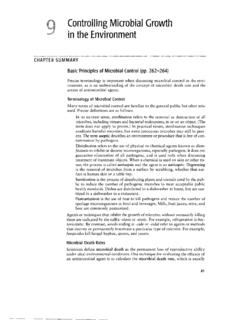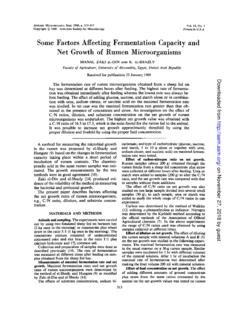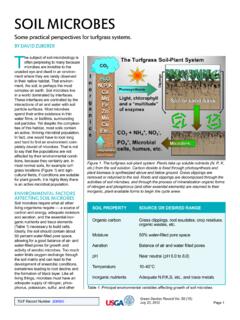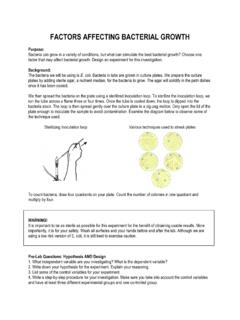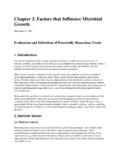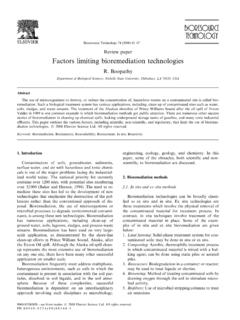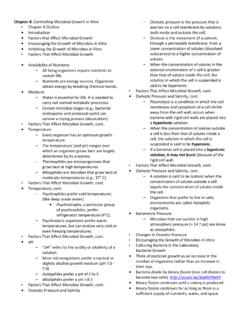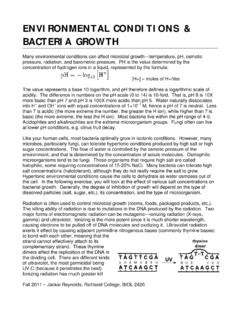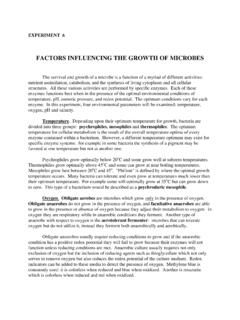Transcription of Inherent Factors Affecting Soil EC - USDA
1 Page 1 Guides for Educators soil electrical conductivity (EC) is a measure of the amount of salts in soil (salinity of soil ). It is an important indicator of soil health. It affects crop yields, crop suitability, plant nutrient availability, and activity of soil microorganisms which influence key soil processes including the emission of greenhouse gases such as nitrogen oxides, methane, and carbon dioxide. Excess salts hinder plant growth by Affecting the soil -water balance.
2 Soils containing excess salts occur naturally in arid and semiarid climates. Salt levels can increase as a result of cropping, irrigation, and land management. Although EC does not provide a direct measurement of specific ions or salt compounds, it has been correlated to concentrations of nitrates, potassium, sodium, chloride, sulfate, and ammonia. For certain non-saline soils, determining EC can be a convenient and economical way to estimate the amount of nitrogen (N) available for plant growth .
3 Inherent Factors Affecting soil EC Inherent Factors Affecting EC include soil minerals, climate, and soil texture which cannot be changed. Salts originate from disintegration (weathering) of minerals and rocks. In areas with high amounts of rainfall, soluble salts from minerals and rocks are flushed below the root zone, eventually into deep groundwater systems or into streams that transport salts to the ocean. Conversely, in arid areas or in areas where less rainfall occurs or saline irrigation water is used, soluble salts are more likely to accumulate and remain near the soil surface, resulting in high EC.
4 Salt-affected soils mainly occur in the western United States; in arid or semiarid areas where annual rainfall is low. Because salts move with water; low areas, depressions or other wet areas where water accumulates tend to be higher in EC than surrounding higher-lying, better drained areas. Clay soils dominated by clay minerals that have a high cation-exchange capacity (CEC), such as smectite, have higher EC than clay soils dominated by clay minerals that have a low CEC, such as kaolinite.
5 Soils with restrictive layers, such as claypans, typically have higher EC because salts cannot be leached from the root zone and accumulate on the surface. Infiltration water can also interact with underlying bedrock that weathers releasing salts which creates saline seeps where it exits. Salinity ManagementSoil EC is affected by cropping, irrigation, land use, and application of fertilizer, manure, and compost. When managing for salinity on irrigated land, irrigation water salinity must also be measured.
6 Irrigating in amounts too low to leach salts, or with water high in salts, allows salts to accumulate in the root zone, increasing EC. Existing salinity levels and amount of salt contained in manure and municipal waste need to be closely monitored to prevent salinity problems, especially in arid climates. Nitrogen fertilizer application can increase salinity and should be monitored closely, especially on sites with potential salinity concerns. Page 2 Guides for Educators soil Electrical Conductivity soil Quality Kit usda -NRCS Management that leads to low organic matter, poor infiltration, poor drainage, saturated soil , or compaction can increase EC and the soil s ability to buffer EC.
7 When irrigating, additional water beyond crop needs can be used to flush excessive salts below the root zone and maintain a EC level, which is based on crop tolerance. Care is needed when applying extra water to leach salts because soils can become waterlogged, allowing salts to accumulate. Leaving crop residue on the surface limits evaporation, and retains soil moisture allowing rainfall and irrigation to be more effective in leaching salts. In some cases, a combination of irrigation, and drainage is necessary to reduce salinity.
8 Good soil management measures to maintain soil organic matter and overall soil health, must be utilized to maintain the desired EC level. Problems Related to EC and Relationship of EC to soil Function Electrical conductivity levels can serve as an indirect indicator of the amount of water and water-soluble nutrients available for plant uptake such as nitrate-N. Areas of saline soils need to be identified and managed differently from areas of non-saline soils. soil microorganism activity declines as EC increases.
9 This impacts important soil processes such as respiration, residue decomposition, nitrification, and denitrification (Table 1). Soils with a high concentration of sodium salts (sodic conditions) have additional problems, such as poor soil structure, poor infiltration or drainage, and toxicity for many crops. Each crop has a salt tolerance. Table 3 shows the percent yield reduction based on the soil EC levels. EC1:1 readings less than 1 dS/m, soil are considered non-saline (Table 2) and do not impact most crops and soil microbial processes (Tables 1 and 3).
10 EC1:1 readings greater than 1 dS/m, are considered saline and impact important microbial processes, such as nitrogen cycling, production of nitrous and other N oxide gases, respiration, and decomposition; populations of plant-parasitic nematodes can increase; and increased nitrogen losses. Even slight to moderate salinity can impede crop growth as shown in Figure 1. Figure 1. EC1:1 values using compost and tap water for tomatoes (Gage, 2012). * EC1:1 values of compost adjusted for well water EC values of dS/m to values for distilled water are shown as footnoted values below each pot in Figure 1.










